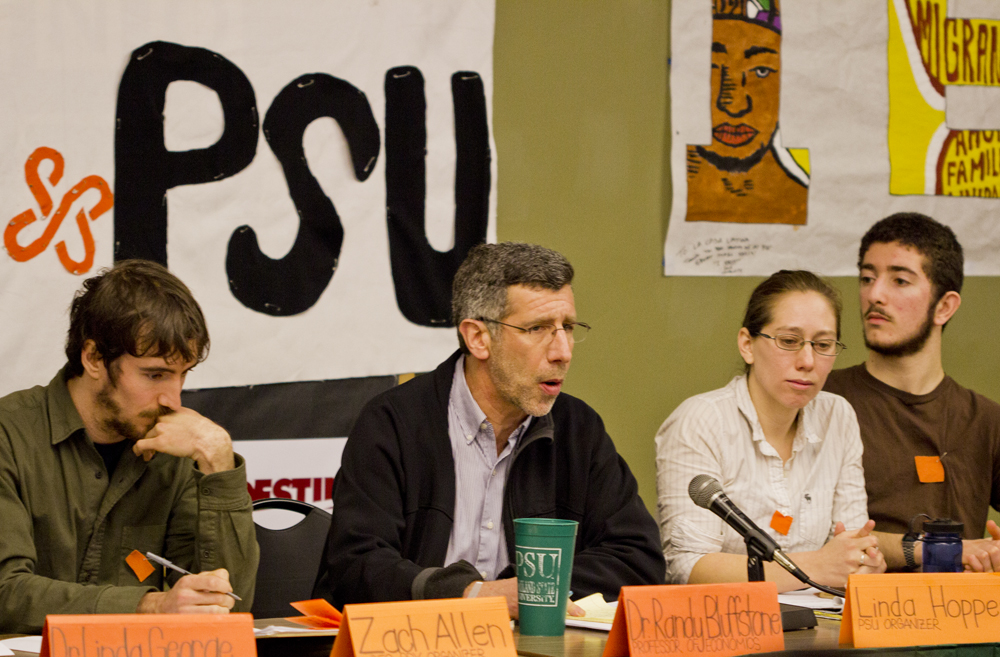Since Fall 2014, Portland State has implemented a payment plan option for students to cover their education costs in three montly installments.
The PSU Payment Plan has been subject to criticism of the policies associated with the alternative form of payment.
“[T]he impact is extremely significant upon students who really don’t have the ability to pay by the sixth of the first month or by two days into the term,” said Eric Noll, Associated Students of Portland State University president. “And those typically tend to be international students, out of state students, low income students, Native American students who receive tribal funding or have unique funding structures.”
Post-baccalaureate student Sean Mahoney said he has experienced difficulties by enrolling in the payment plan. He criticized the plan as an added burden to students’ educational costs.
“This policy is new,” Mahoney said. “[In] fall of 2014 they just said ‘here it is.’ And it’s been in place for a term and a half now, and it’s really becoming apparent how detrimental it can be.”
The payment plan charges a $100 late fee for each installment students are late on tuition payment, so students may be charged up to $300 per term in late fees. This fee is in addition to enrollment and processing fees associated with the payment plan. This is higher than other Oregon universities, which typically charge a small percentage of tuition. For example, University of Oregon charges a $6 billing fee for every past due balance. Students have a 10 day grace period on late payments and the annual interest rate on unpaid bills appreciates up to 9 percent.
The university charged Mahoney a late fee after he reached his credit maximum as a post-baccalaureate student. He needed to file a petition to take more credit hours. But, Mahoney said, by the time the university approved him for 30 more credits, he had been charged a $100 late fee because his financial aid had not disbursed.
“I don’t know how [late fees are] benefiting the community at all,” Mahoney said. “So I’m paying a $100 late fee…I don’t know what I’m doing or why that’s needed or why that’s meaningful.”
Mahoney continued by discussing fees that will be implemented next year.
“Next year if you don’t pre-enroll in this payment plan, they’re going to be charging you $35 at the beginning of every term to enroll you in the [plan],” Mahoney said. “So if you’re having some kind of struggle financially or you don’t know about it or English is your second language, then whatever your tuition is, even if it’s in-state, [it could be] $3,000, then you have $300 in late fees. That’s a 10 percent bump in tuition, right there.”
“The students are working really hard to get a good education, and it’s not fair for them to be saddled with additional debt and additional hardships because it seems like the university’s looking for more money,” Mahoney added.
A change of pace at PSU
Until this year, all students were expected to pay their balance in full by the start of every term.
In 2008, PSU conducted a survey about how to better serve students, said Director of Communications at PSU Scott Gallagher. This survey began a discussion about possibly creating an alternative way to pay for school.
“Currently, all public universities are pretty much the same…they all charge the tuition for the quarter, they have billing fees, they charge interest when it’s not paid, and they also charge late fees,” Gallagher said.
PSU is the first public university in Oregon to adopt something like the payment plan, Gallagher said.
This fall, students had the option to opt into the payment plan by Oct. 6 or be automatically enrolled and face a $100 fee if unable to pay the term’s tuition in full upfront. A late fee of $100 is added for every monthly installment not paid on time.
“We don’t want that money,” said Associate Vice President of Budget and Finance at PSU Alan Finn. “We would rather collect $0 [in fees] and have every student pay their bills.”
The $100 fee works to encourage timely payment, Finn said.
Starting during the 2015–16 school year, it will cost $35 per term to enroll in the plan, according to the PSU website.
So far, the payment plan is estimated to accrue $800,000 in revenue from fees per year, Noll said.
The $800,000 is no more than the amount of revenue gained from fees and interest before the plan, Finn said, but fewer students are contributing to the sum.
“If we’re doing our job correctly, the revenue should drop significantly,” Finn said.
The money goes directly to the general fund and is small in the face of the $2 million of student debt that PSU writes off annually, Gallagher said.
If the student’s term balance is not paid in full by the date of the third installment, the student will have their preregistration for the following term cancelled.
“Financially, by un-enrolling students who haven’t paid down their account balance, it reduces the risk of the institution of students accruing a significant amount of debt and defaulting on their loan,” Noll said. “From our perspective, it’s a financial risk-management policy…on the part of the institution.”
Gallagher described things differently. “[Cancellation of pre-registration] sounds really bad, but that also helps some students and prevents them from going further into debt when they’re not ready for it,” Gallagher said.
“That’s, not to be cruel, an indirect way of helping protect them,” he added.
ASPSU Multicultural Affairs Director Tony Funchess said this policy does not help students.
“This will keep students from accessing education that will get them jobs to get them out of debt,” Funchess said.
In early December, 1,200 students were in danger of being un-registered for winter term as a result of the payment plan. Ultimately, 35 students were unable to register at all for winter term.
Risk for international students
The issue of un-registering students has been a concern among PSU’s international student populations who lose student visas as a consequence of being unable to attend PSU the following term.
Before the payment plan, students were allowed to continue the following quarter without paying tuition on time, but would receive interest and account holds, said Academic Affairs Director at PSU Tia Gomez-Zeller.
Gomez-Zeller said students from countries such as Syria may be escaping turmoil and may also have issues receiving funds from their countries due to destruction or less established financial institutions.
“By putting this payment plan in place, it creates an additional barrier and stress factor on those student lives, while we still expect them—as their families and their culture and their community expects them—to be excellent students,” Funchess said.
“If you put a hold on my account and I’m registered for classes, I don’t have to worry about my immigration status,” Gomez-Zeller said. “If you drop me out, [as an international student] the moment I get dropped out, I have 30 days to leave the country.”
“Every student’s impacted because we’re a community,” Gomez-Zeller said.
Gallagher said the effect on the international students is an unfortunate side effect of this policy change.
“But you have to understand that our purpose is to help students get a degree and move on…Our purpose is to educate, not provide a visa,” Gallagher said.
Barbara Payne, member of the ASPSU Judicial and Constitutional Review Board, said international students may have difficulty navigating the procedures of the payment plan.
“International students, who may or may not have command of the language in the emails that come from PSU, are getting these [payment plan] emails, and if anything outstanding is going on, and with international students there are a lot of hiccups…their housing is now under scrutiny because of this payment plan,” Payne said. “We’re talking about all of these domino effects of things that can happen to a student if in fact…PSU doesn’t get their money when they’re supposed to.”
Gomez-Zeller noted that some international students who have been at risk for deportation because of unpaid tuition have received forgiveness or assistance from administration and the Office of International Affairs here at PSU.
Impact on PSU diversity
This year’s incoming freshman class is made up of 40.3 percent students of color.
Funchess explained that the payment plan’s ability to un-register students may decrease diversity.
“[We] can’t figure out how to retain students, and a payment plan is not a way to retain students. It’s a way to lose students,” he added.
Funchess pointed out low numbers of African American students at PSU, which has an African American student population of 3 percent. Of the Urban 21 Universities, PSU has the lowest number of African American students, Funchess said.
Native American students from certain tribes may face particular difficulty attaining their tribal funding by the sixth of every month.
The Native American student population has grown from 244 students in 1999 to 380 students in 2014, according to Coordinator of Native American Student Services Dean Azule. For some of those students, attaining funds for school can be a challenge.
Some indigenous students aren’t affected by the payment plan, while others are because of tribal funding.
“At the start of the term, some kids [didn’t] realize they didn’t receive their scholarship from the tribe,” Azule said.
“A lot of students I dealt with didn’t realize the [late] fee could be waived with good reason,” Azule said.
“There are lots of special circumstances with our students, and we tried really hard to pre-communicate this with as many people as we could,” Finn said.
Azule has met with Student Accounts on a regular basis. Megan Looney of Financial Services has been very helpful in solving one-on-one cases regarding issues with the payment plan, Azule said. He expressed that possibly there should be more than the two available options for paying tuition.
Stresses for students
Some feel there was a lack of conversation about implementation before the payment plan was put into place this fall.
Funchess said PSU’s Office of Finance and Administration did not consider the impact the payment plan would have on the students.
“They instructed and informed about what was going to happen, but they did not do any of the work necessary to find out how to implement this in a way that it would actually be beneficial,” Funchess said. “It’s been beneficial for the institution in the capacity that they will raise approximately $800,000 on the backs of students who are already strapped to pay for their education.”
Both Funchess and Gomez-Zeller said representatives from the Office of Finance and Administration visited ASPSU to speak about the payment plan before it was implemented, but did not open the plan up for discussion.
“I think it would be more useful if there was a discussion before implementation,” Gomez-Zeller said.
“What this payment plan is doing is putting up an additional barrier that is hindering communities of color,” Funchess said. “And it has been done without any thought, without any conversation, without any recourse for those that are the most impacted by it.”
Gallagher pointed to the slow-moving timeline of policy implementation in a university setting. Initial discussion of a potential alternative to tuition began in 2008. Students concerned today might not have been around during the conversation in 2008, Gallagher said.
Other complaints stem not from the financial side, but from the IT standpoint.
Payne’s qualms with the plan originally stemmed from a string of emails she received toward the end of fall term and throughout winter break. She described them as stressful.
“Especially for people who have financial aid, there need to be concessions made because we shouldn’t be getting those emails,” Payne said.
Before the start of winter term, Payne let an $88 parking permit fee go to her student account. Any balance over $50 remaining in a student account before the start of term results in enrollment in the plan.
“I had $88 outstanding, and the payment plan kicks in and all of a sudden I owe $44 by the first,” Payne said. “Otherwise I’m going to get hacked for $100. It just kills me, because it’s not tuition. It’s a parking permit, and I can choose to do whatever I want with my student account.”
“I had another friend whose financial aid didn’t come through because of a technicality…” Payne said. “You’ve got technicalities and little things here and there, whatever they may be, and all of a sudden you’re kicked out of school, you can’t pick your classes, you’re going to lose your housing, and the whole thing just turns into a monster.”
At the ASPSU meeting on Feb. 11, some members expressed the concern that the $50 balance minimum for the plan had not been holding true.
Fundamental question of education
According to Gallagher, Oregon is 47th in state funding for higher education. For this reason, Gallagher said, PSU is tuition-dependent.
“We are so dependent on the revenues that we get from student tuition and fees that if there are students who can’t afford to pay that tuition and fees,” Finn said. “Yet we’re providing that education for them—we’re kind of in a bind because we want so badly to help that student get to the finish line, but we need the money to do it, too. No one has found that answer yet.”
Oregon Students are currently advocating for $755 million in state funding for public universities. This is an effort to avoid potential tuition increases, according to J.P. Cummings of the Oregon Student Association.
“Because if the state isn’t willing to pay for it, and the student can’t afford to pay for it, who’s going to pay for it? That’s where we get kind of stuck in the middle,” Finn said.
Future plans
At an ASPSU Executive meeting on Feb. 11, members discussed their future involvement with the payment plan.
Noll met briefly with Vice President of Finance and Administration Kevin Reynolds on the subject in early February.
“He and his department are asking a lot of questions…there is a lot of flexibility, based on the conversation, to change or adjust the payment plan,” Noll said.
The Student Fee Committee is currently working on a resolution to help solve issues regarding the payment plan.
“Members of the SFC are extremely excited to get something going with the PSU payment plan and to work with anyone inside or outside of ASPSU,” said SFC Committee Chair Alexandra Calloway-Nation.
The SFC hopes to introduce their resolution before spring term, Calloway-Nation said.
Calloway-Nation said the SFC has discussed the possibility of removing the $35 enrollment fee and making the $100 late fee easier to have waived.
Currently, ASPSU is working on gathering testimony from students who may have had issues with the plan this year.
Gallagher and Finn encouraged students to call Student Financial Services with issues related to the payment plan.
“Please call us, and we’ll talk to you,” Finn said.
Additionally, students facing difficult circumstances are encouraged to reach out to the many resource centers available at PSU.
“We need the students to become engaged in their education beyond the classroom,” Funchess said. “There’s an accountability here where everyone is accountable for this. No one just gets to sit on the sidelines.”
Additional reporting by Miles Sanguinetti.
Students can email aspsuprs@pdx.edu with their own stories about the payment plan. Students may call Student Financial Services at 503–725-3440 with any issues.





what’s really messed up is that I paid a third of the tuition before enrolling in the plan, then when i enrolled they wanted me to pay a third of the current balance. The system went from flexible to neck breaking.
My financial aid hasn’t distributed yet, so I tried to pay a third of my balance with my HigherOne account, which of course isn’t listed as an option when you try to enroll in the payment plan. But then I made the mistake of paying the third without officially enrolling, and now owe a third of the balance I just reduced. Ridiculous.